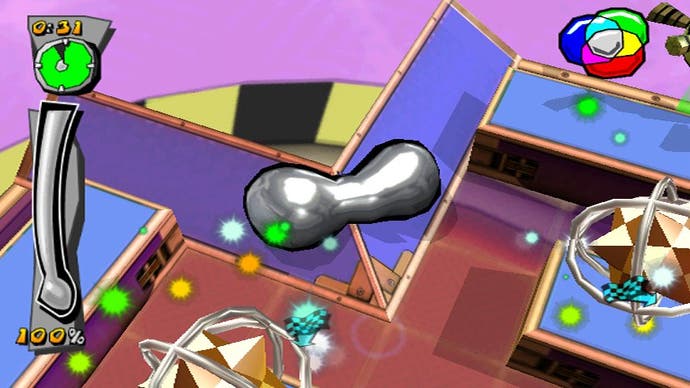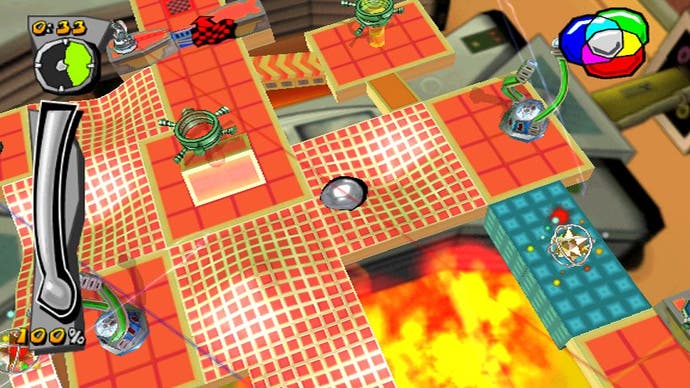Mercury Meltdown Revolution
You say potato.
You're about to have dinner in the living room, but you're in the kitchen. You've got a large plate of steaming vegetables. You pick it up with your right hand and start walking towards the door. But oh no! A potato is rolling towards the abyss! Quickly and expertly, you adjust the angle of the plate. The potato goes flying out of the nearest window.
What went wrong? Your actions made sense to your brain. And yet even though you interpreted all the available information about potato and plate position sensibly, your adjustment proved to be spectacularly heavy handed. The potato didn't seem to react until it was much too late, and it moved so swiftly once it did that you had no chance to prevent it taking flight. Sitting down to eat, you pick up a fork and accidentally stab your wife in the knee.
But that's enough about Super Monkey Ball: Banana Blitz. It's already caused enough trouble. Most annoying is that it's kicked off this daft debate about whether the Wiimote is up to the job. Can it measure things accurately enough? Does it even matter, since it can't offer the same kind of tactile positional feedback as an analogue stick?

Ignition's Ed Bradley, introducing Mercury Meltdown Revolution and discussing the Wiimote's capabilities, tried to answer these questions. His first answer was yes. His second one was a bit more interesting. Having earmarked lots of time to the process of adapting Mercury's subtle controls to the Wiimote, "it ended up being more straightforward than we anticipated".
Settling down to play the game, it's immediately obvious why. Mercury - in case you've tumbled in here with no prior knowledge of it - is about moving a blob of liquid metal around a maze. The maze is the bit you're actually controlling, and judging movement is partly a question of knowing where the analogue stick is beneath your thumb and partly about watching the way the camera and maze react to each input. Playing with the Wiimote, camera and maze movement are still critically important, but it turns out that being able to feel the analogue stick isn't such a huge loss - because it does a much better job of feeling like juggling vegetables on a plate.
For a start, you hold the Wiimote with both hands, with the buttons facing the ceiling. Imagine you're holding the plate on both sides. In order to avoid dropping things, you need to move your hands up and down slightly, relative to one another. For this to work, you need appropriate visual feedback. Obviously you get this from a plate, and your brain quickly sends signals to your hands, which adjust. MMR simply does a better job of replicating this than anything else. When your blob starts to slip toward the abyss on-screen, your brain and hands collaborate to articulate an appropriately subtle response, taking their cues from the visual feedback on the TV. Or, to put it another way, it just works. You don't even have to think about it.

The other elements of Mercury control are easily catered for by the buttons, which you'll find are neatly arranged beneath your thumbs. Just like the old days! The d-pad turns the camera 90 degrees. The 1 and 2 buttons zoom it in and out. The trigger button on the underside switches focus between different blobs of mercury. It's still tricky to keep track of multiple parts, and your paranoia about losing control in complex situations sometimes leads to over-adjustment, but the learning curve for settling into the new approach is surprisingly gentle.
A few minutes after tilting my way gingerly through the opening mazes, I was able to skip the game to later levels and tackle tricky vertical challenges that involve mixing colours while moving up and down a complex 3D arrangement of platforms and conveyor belts. Relative to the amount of time I've spent playing the PSP versions of Mercury, this Wii session was over in a flash - but by the time I handed the remote back to our guide and headed off to catch the train home, it already felt just as comfortable playing with the Wiimote as it had with the PSP's analogue nub.
The only slight disappointment to be found was that the party games, offered as multiplayer pursuits primarily, haven't been adapted to make better use of the Wiimote. Those who played the PSP Meltdown might imagine that curling, in particular, could be reworked to rival even Wii Sports Bowling. Sadly this isn't the case. Instead you point the stone with the remote and then press buttons to fill a power bar. Other efforts like racing and rodeo maintain their characteristics, having used the tilting of the analogue stick in the first place, but they remain a bit throwaway - albeit better in multiplayer, which is still offered here.

On the whole though, it's great news. If you never paid much attention to Mercury Meltdown, you really should now. There are over 160 mazes to puzzle through, and the progression system is such that if you get stuck you can simply go onto the next one. You can get to the last maze in the game without actually having to complete the first one - do enough of the rest quickly enough, and without letting much of your liquid mercury slip off the edge of the plate, and you'll unlock things regardless.
On the PSP, we loved it. The best thing you can do to get yourself excited about the Wii version is read our review. Preferably while holding the Wiimote in your hands, and balancing a potato on top. It's coming soon, and it's going to be a bit tasty.
Mercury Meltdown Revolution is due out in March.


.png?width=291&height=164&fit=crop&quality=80&format=jpg&auto=webp)




.jpg?width=291&height=164&fit=crop&quality=80&format=jpg&auto=webp)
